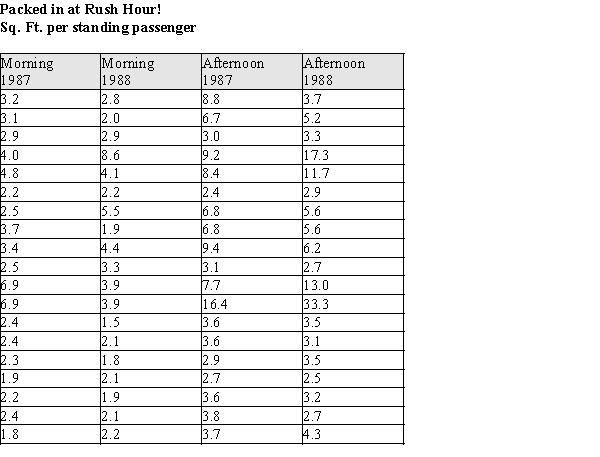Essay
Exhibit 3-2
In 1990 the New York Times reported the average number of square feet per standing passenger in 1987 and 1988 for 19 subway stops. Although the sampling method was not reported, we will presume that these data represent a random sample of days during the morning and evening rush hours. The NYC Transit Authority managers attempted to improve the space problem on subway cars (more space is better--trust us!) by adding cars to trains during the rush hours. They gathered the 1988 data to check on their efforts after one year. The data are in the table below. 
-Refer to Exhibit 3-2.
The MTA guidelines in 1987 specified a minimum of 3 square feet per standing passenger. The engineers would like to report standardized measures (z-scores) of this target value. That is, for each year and time of day, they will report how far away the target value of 3 feet is relative to the different distributions.
(a)Consider the original passenger space data for the morning rush in 1987, used in Exhibit 3-2. What are the mean and standard deviation for the sample?  =
=
s =
(b)How many standard deviations above/below the mean is the target value of 3 feet for the distribution in part (a)?
Correct Answer:

Verified
a)  = 3.24 sq. ft. per standin...
= 3.24 sq. ft. per standin...View Answer
Unlock this answer now
Get Access to more Verified Answers free of charge
Correct Answer:
Verified
View Answer
Unlock this answer now
Get Access to more Verified Answers free of charge
Q5: Astronomers are interested in the recessional velocity
Q6: The Territory of Iowa was initially surveyed
Q7: A wide variety of oak trees grow
Q8: The table below summarizes the number of
Q9: The data in the table below are
Q9: If there are no outliers, a skeletal
Q11: In order to attribute changes in nest
Q12: Exhibit 3-2<br>In 1990 the New York
Q13: Consider a study in which the heights
Q14: Exhibit 3-1<br>In recent years there has been